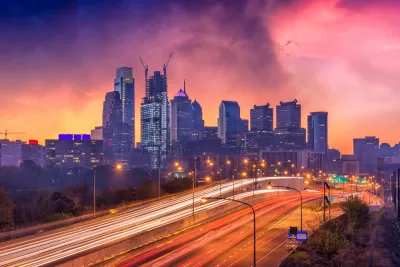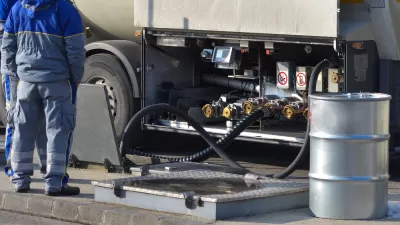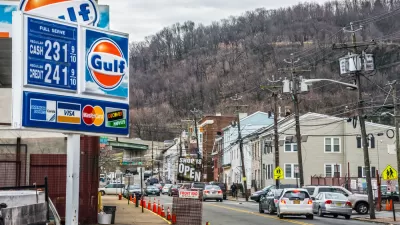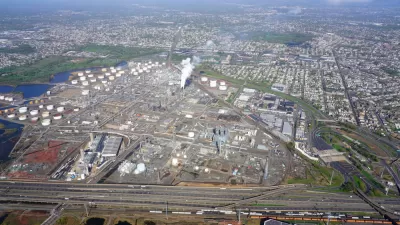Nine Mid-Atlantic and Northeast states and the District of Columbia have agreed to work together to develop a policy to price emissions from transportation, set a 'cap' on them, and invest the revenues in low carbon transportation solutions.

Connecticut, Delaware, Maryland, Massachusetts, New Jersey, Pennsylvania, Rhode Island, Vermont, Virginia, and District of Columbia belong to the Transportation and Climate Initiative (TCI), a regional collaboration that formed in 2010 to improve transportation, develop the clean energy economy and reduce carbon emissions from the transportation sector, the largest source of emissions in most of these states as well as the nation.
According to the initiative statement [pdf] signed Dec. 18, "the participating TCI jurisdictions will design a regional low-carbon transportation policy proposal that would cap and reduce carbon emissions from the combustion of transportation fuels through a cap-and-invest program or other pricing mechanism, and allow each TCI jurisdiction to invest proceeds from the program into low-carbon and more resilient transportation infrastructure."
The participating TCI jurisdictions plan to complete the policy development process within one year, after which each jurisdiction will decide whether to adopt and implement the policy
Fuel distributors in the nine states and D.C. will be required "to buy pollution permits [or allowances] for some of the carbon they produce," writes David Abel, environmental reporter for the Globe.
"We estimate that at modest allowance prices that would cost the average driver $6 per month, the program could bring approximately $3.5 billion into the region for clean transportation investments," writes Ken Kimmel, president of the Union of Concerned Scientists.
While there are a number of policies in place to lower transportation emissions (fuel economy standards for cars and trucks, incentives and mandates for electric cars, and investments in public transit), transportation sector emissions are expected to stay flat, and may even rise.
Why? Among other things, we are missing two key pieces: 1) a legally binding mechanism to force overall emissions down; and 2) a revenue source to fund the transition to cleaner transportation.
"If approved, the agreement would be modeled after the Regional Greenhouse Gas Initiative, a nine-state regional “cap-and-invest” system for power plant emissions known as RGGI," adds Abel.
Widely seen as a national model, the mandatory market-based program has helped reduce power plant emissions from Maryland to Maine by about 40 percent below 2005 levels without raising average electricity prices.
All but Pennsylvania, New Jersey, Virginia and D.C. are RGGI members, though Gov. Tom Murphy (D-N.J.) announced on Monday that "the Department of Environmental Protection has formally proposed two rules that will steer New Jersey’s re-entry into the Regional Greenhouse Gas Initiative."
RGGI members New Hampshire, New York, and Maine have not signed, although New York and Maine are expected to. It is unclear why New York has not signed yet, but Maine is expected to join the coalition after its newly elected governor, Janet Mills, takes office next month.
Fuel allowance revenues would be spent for a variety of low carbon transportation programs that would be selected by each jurisdiction, "including public transit, carpooling and driverless car services, subsidies to accelerate the adoption of electric vehicles, and new bike lanes," notes Abel.
TCI is facilitated by the nonpartisan Georgetown Climate Center, part of Georgetown Law.
Additional reading:
- Utility Dive, Dec. 18: "Regional initiative to reduce transportation emissions would mirror RGGI."
- TCI press release: "Nine States and D.C. to Design Regional Approach to Cap Greenhouse Gas Pollution from Transportation."
- NJ Department of Environmental Protection news release: "New Jersey to Participate in Design of Regional Approach to Reduce Greenhouse Gas Emissions trom Transportation Sector."
FULL STORY: In landmark agreement, Mass., eight other states vow to cut transportation emissions

Study: Maui’s Plan to Convert Vacation Rentals to Long-Term Housing Could Cause Nearly $1 Billion Economic Loss
The plan would reduce visitor accommodation by 25,% resulting in 1,900 jobs lost.

North Texas Transit Leaders Tout Benefits of TOD for Growing Region
At a summit focused on transit-oriented development, policymakers discussed how North Texas’ expanded light rail system can serve as a tool for economic growth.

Using Old Oil and Gas Wells for Green Energy Storage
Penn State researchers have found that repurposing abandoned oil and gas wells for geothermal-assisted compressed-air energy storage can boost efficiency, reduce environmental risks, and support clean energy and job transitions.

From Blight to Benefit: Early Results From California’s Equitable Cleanup Program
The Equitable Community Revitalization Grant (ECRG) program is reshaping brownfield redevelopment by prioritizing projects in low-income and environmental justice communities, emphasizing equity, transparency, and community benefits.

Planting Relief: Tackling Las Vegas Heat One Tree at a Time
Nevada Plants, a Las Vegas-based nonprofit, is combating the city’s extreme urban heat by giving away trees to residents in underserved neighborhoods, promoting shade, sustainability, and community health.

How Madison’s Tree Planting Efforts Are Growing a Healthier Community
Madison’s annual tree planting initiative is enhancing environmental resilience, public health, and community livability by adding 1,400 carefully selected trees citywide, with strong community and institutional support for urban forestry.
Urban Design for Planners 1: Software Tools
This six-course series explores essential urban design concepts using open source software and equips planners with the tools they need to participate fully in the urban design process.
Planning for Universal Design
Learn the tools for implementing Universal Design in planning regulations.
Ascent Environmental
Borough of Carlisle
Institute for Housing and Urban Development Studies (IHS)
City of Grandview
Harvard GSD Executive Education
Toledo-Lucas County Plan Commissions
Salt Lake City
NYU Wagner Graduate School of Public Service





























